2024 is ‘almost certainly’ the warmest year on record – and the first year above 1.5°C, scientists say
Britain may be starting to feel the winter chill, but it is now ‘almost certain’ that 2024 will be the hottest year on record.
According to the Copernicus Climate Change Service (C3S), the average temperature in the first ten months of the year has been 0.16°C (0.29°F) higher than in 2023.
It means that 2024 will definitely surpass 2023 as the hottest year on record worldwide.
And with temperatures likely to surpass last year’s record highs, 2024 is on track to be the first year to be 1.5°C above the pre-industrial average.
Samantha Burgess, deputy director of C3S, said: ‘Ten months into 2024, it is now almost certain that 2024 will be the hottest year on record and the first year with more than 1.5ºC above pre-industrial levels.
‘This marks a new milestone in global temperature records and should serve as a catalyst to increase ambition for the upcoming Climate Change Conference, COP29.’
In addition, last month was the second warmest October on record, just behind 2023 with an average global temperature of 15.25°C (59.45°F).
At 1.65°C above pre-industrial levels, October is the 15th month in a 16-month period in which temperatures exceed the Paris Agreement targets.
Scientists from the Copernicus Climate Change Service (C3S) say 2024 will now almost certainly be the hottest year on record and the first year in which temperatures will reach 1.5°C above the pre-industrial average
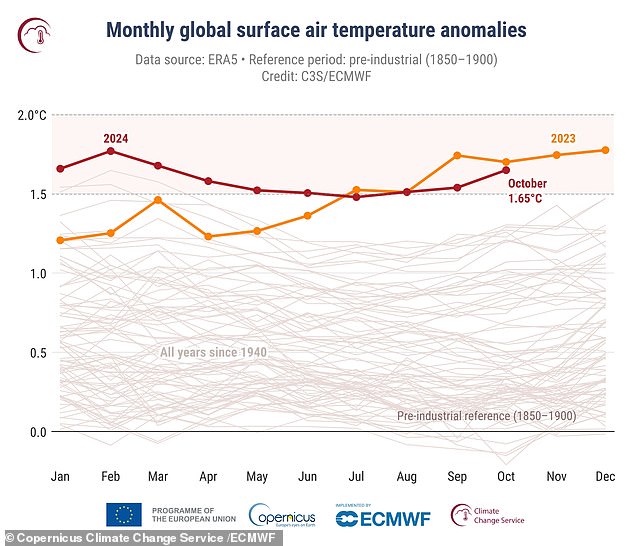
Last month was the second warmest October on record, just behind the record temperatures of 2023. Around the world, the average surface temperature was 15.25°C (59.45°F).
C3S’s observations come from analysis of the ERA5 dataset, which contains billions of measurements from ships, aircraft, satellites and weather stations around the world.
Together these provide a reliable and accurate estimate of the monthly temperature average around the world.
This shows that October 2024 was the second warmest October worldwide and the fifth warmest on record in Europe.
Temperatures were particularly high in Central and Western America, Canada, Japan and Australia.
In Japan, abnormally high temperatures left the iconic peak of Mount Fuji snowless for the longest period since record-keeping began 130 years ago.
While snow normally descends on the mountain around October 5, this year the summit remained bare until early November.
This follows the hottest summer on record, with global temperatures rising 0.69°C (0.24°F) above average in June, July and August.
C3S found that August 2024 was the warmest August on record, when the average global temperature rose to 16.82°C (62.28°F), leading to widespread drought and dangerous heat waves.

C3S says temperatures have been particularly warm in central US, northern Canada and Japan, where the iconic peak of Mount Fuji (pictured) remained snowless until early November
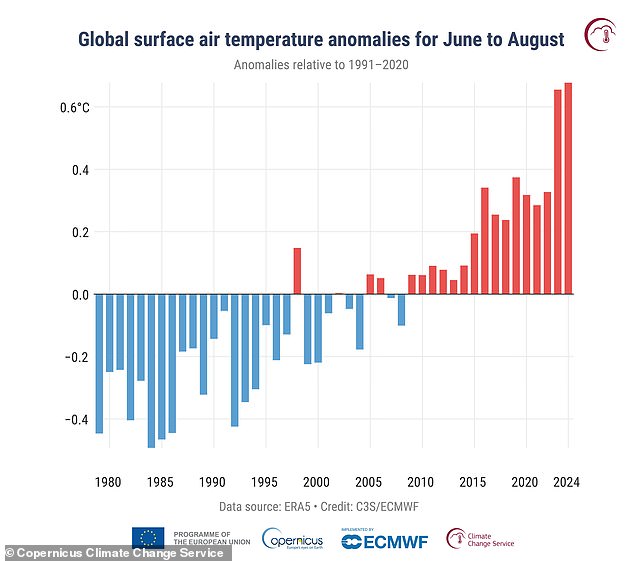
During a record-breaking summer, the average temperature was the highest on record at 0.69°C above the 1991-2020 average, surpassing the previous record from June to August 2023 (0.66°C).
And in the twelve months from November 2023 to October 2024, the average surface temperature was 0.74°C (1.33°F) above the 1991-2020 average.
Moreover, that period was 1.62°C (2.91°F) above the average of 1850-1900, the period used by scientists as a benchmark for the pre-industrial era.
This means that 2024 will almost certainly be hotter than the record-breaking 2023, which had the hottest summer in 2,000 years.
Worryingly, C3S now predicts that by 2024 it will almost certainly also be 1.55°C above the pre-industrial average.
This is a concern because in 2016, 28 countries signed the Paris Agreement, committing to keeping global temperature rise below 1.5°C.
The famous pact was intended to mitigate the worst effects of man-made climate change and prevent irreparable damage to the environment.
In previous years, individual months have exceeded the Paris Agreement limit.
However, 2024 would be the first year in which the year-round global average surface temperature is more than 1.5°C above the pre-industrial average.

Scientists say rising temperatures have made devastating floods in Valencia, Spain more powerful. With temperatures rising more than 1.5°C above pre-industrial averages, scientists warn that extreme weather events will only become more likely
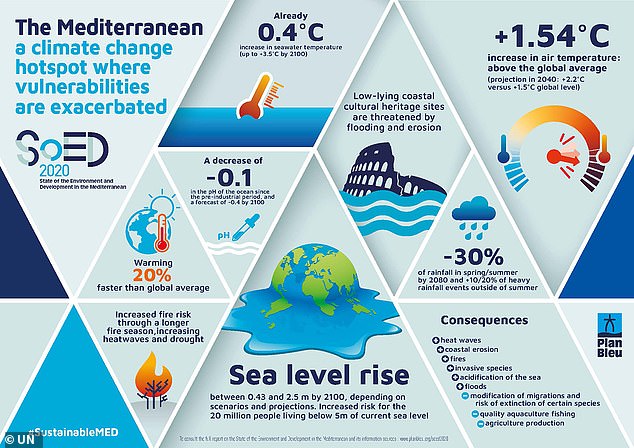
Studies have shown that the Mediterranean – home to more than 510 million people – is warming 20 percent faster than the global average
As global warming increases the risk of extreme weather patterns, these findings have raised concerns about the threat posed by climate change.
1.5°C is seen as a threshold above which the worst impacts of climate change-induced heatwaves, droughts, floods, the collapse of natural systems and rising sea levels will be felt.
This month, Spain was rocked by the country’s deadliest climate disaster when flash floods ravaged the Valencia region.
Scientists say there is “no doubt” that these explosive rains have been exacerbated by human-induced climate change.
Mike Childs, head of science, policy and research at Friends of the Earth, said: ‘Our ailing planet sends us every signal that it is in crisis – the most recent being the deadly floods in Spain that have claimed the lives of so many. and caused enormous damage.’
Mr Childs added: ‘The time for hesitation and delay is long gone.
“We need world leaders to break the emergency glass now and do everything in their power to prevent further damage.”
There are particular concerns about the increasing possibility of ‘mega-hurricanes’ caused by warming oceans.
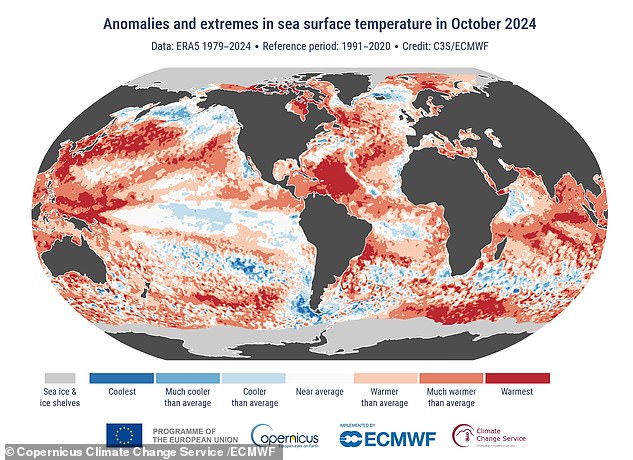
Sea temperatures in October (pictured) were at the second highest level of the month this year. Scientists say warmer seas increase the risk of severe storms and hurricanes over the Atlantic Ocean
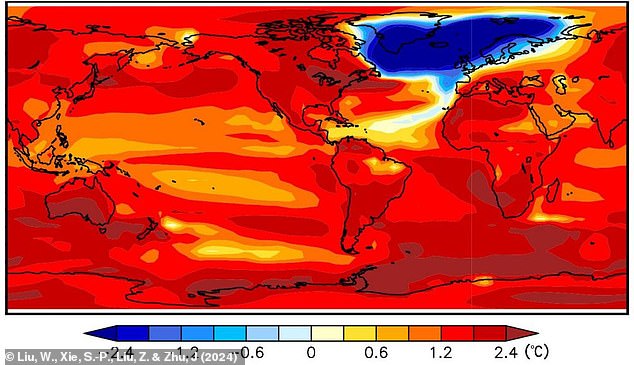
C3S also found that sea ice coverage was 19 percent lower than average. Some research suggests that melting sea ice could lead to the collapse of ocean currents, creating a ‘cold bubble’ over Europe (pictured) and plunging Britain into a ‘new ice age’.
Warmer air contains more energy and can hold a greater amount of moisture, which not only makes storms more common but also increases their destructive power.
Scientists largely agree that areas like Florida are at increasing risk of extreme weather due to warmer temperatures in the Gulf of Mexico, where Atlantic hurricanes typically form.
The latest C3S report also shows that the average sea surface temperature for October 2024 (another metric that measures heat close to the ocean surface) was 20.68°C (69.22°F).
This is the second highest sea surface temperature value ever recorded for the month, and only 0.10°C (0.18°F) lower than the temperature recorded for October 2023.
Moreover, rising temperatures have also led to a reduction in global sea ice coverage.
C3S found that sea ice reached its fifth lowest level in October, 19 percent below average.
In Antarctica, sea ice extent fell to the second-lowest level on record this month, 8 percent lower than average, just behind 2023 levels.
Recently, an international group of scientists warned that an influx of freshwater from melting sea ice could destabilize a critical set of ocean currents, including the Gulf Stream.
If this current system were to collapse, it could plunge Europe into a ‘new ice age’ and flood large parts of the US Atlantic coast.
Mr Childs added: ‘With the UN climate talks approaching, Britain must come forward with stronger plans to meet our climate and nature targets, as well as a credible strategy to prepare for the extreme weather and the broader consequences of climate change that are already visible. ingrained.’
